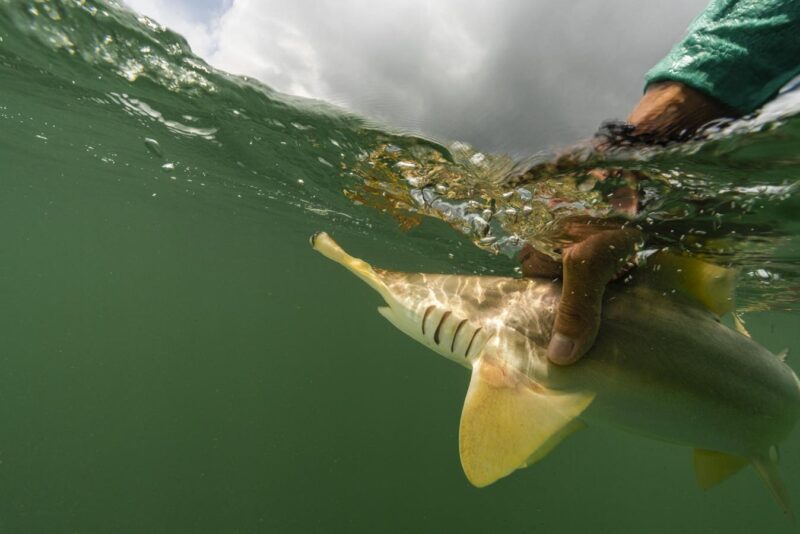Juvenile scalloped hammerheads, once a common sight gliding through Colombia’s coastal waters, have become increasingly rare.
Provided by Diego Cardeñosa
The story of sharks in Colombia was once one of loss.
Juvenile scalloped hammerheads, once a common sight gliding through Colombia’s coastal waters, have become increasingly rare. For generations, fishers could count on seeing their small, distinctive silhouettes near mangroves and river mouths, but now entire seasons can pass without a single one appearing in their nets. The same is true for the largetooth sawfish, a species so memorable that older fishers still speak of it with a mix of nostalgia and disbelief. Its long, toothed snout made it unmistakable, yet today, it has nearly vanished from local waters. Younger generations have never seen one in the wild, and only old photographs or weathered stories keep its memory alive here.
This loss has forced many coastal communities to reflect on what’s happening in their ocean. It’s not just about fewer individuals of these iconic species — it’s about the deep changes unfolding in the ecosystems these people depend on. Overfishing, habitat loss, and shifting ocean conditions have all played a part, but so has a lack of awareness about how fragile marine life can be. For decades, sharks were seen mainly as a resource: something to catch, sell, or avoid. But as populations declined, people began to notice the difference. Fewer sharks meant fewer fish overall, and the delicate balance of the sea started to shift. That realization became a turning point. Rather than giving up on the species they once caught, many fishers here are now working to protect them. They are joining scientific surveys, helping tag and release sharks, and teaching younger generations about the importance of conservation. These same hands that once hauled sharks onto boats are now carefully releasing them back into the water, giving them a chance at survival.
When asked why Colombian fishers are shifting from catching sharks to protecting them, Dr. Diego Cardeñosa of Florida International University replied: “Because they see the decline with their own eyes.” Firsthand experience is one of the most powerful motivators for change, transforming abstract numbers or distant conservation warnings into a tangible reality. That direct observation creates a personal connection to the problem: these are not “other people’s sharks”… they are part of their own livelihoods, culture, and memories. Not only that, but this project provides an economic incentive to participate. “We cover the costs of fuel, boats, and personnel for weekly surveys, whether sharks are caught or not. In practice, we pay them for their time and the data they collect, not for the number of sharks they bring in. This avoids creating any bias or pressure to catch more animals and instead establishes a standardized survey method that allows us to reliably track abundance trends over time in these locations. By combining that support with training and new practices, these communities are not only contributing to science but also helping ensure there will still be fisheries, and healthy oceans, for future generations.”
When asked why Colombian fishers are shifting from catching sharks to protecting them, Dr. Diego Cardeñosa of Florida International University replied: “Because they see the decline with their own eyes.”
Provided by Diego Cardeñosa
This transformation didn’t happen overnight. At its heart is education, which “breaks myths,” Cardeñosa explained. For generations, local sharks were cast only as threats or commodities. That limited perspective shaped how communities interacted with the ocean, often prioritizing short-term gain over long-term health. Changing these deeply ingrained beliefs required consistent outreach, hands-on learning, and opportunities for both children and adults to see sharks in a new light. Education programs in these communities go beyond lectures or pamphlets; fishers learn about the specific roles different shark species play in food webs, how juvenile hammerheads influence prey populations, and why maintaining healthy coastal habitats benefits everyone, including the fisheries they depend on. Children participate in school-based activities, storytelling, and interactive workshops that connect sharks to the ecosystems around their homes. Adults see firsthand how monitoring and releasing sharks can support sustainable fishing practices without threatening their livelihoods. When people understand that sharks are not just food or fearsome predators, they begin to see them as essential partners in a thriving ocean. Attitudes shift from extraction to protection, and fishers start thinking about the broader system rather than just the next catch. Over time, this knowledge spreads throughout the community, creating a culture where conservation becomes a shared responsibility, and safeguarding the ocean is viewed as both practical and morally important.
Small hammerhead species — Pacific bonnethead, scalloped bonnethead, scoophead, and smalleye hammerhead — are among the most urgent to protect here. All are Critically Endangered, teetering on the brink of extinction. In fact, their populations have declined so rapidly that without intervention, they could vanish within our lifetimes. “But their loss would mean more than just fewer sharks,” laments Cardeñosa. “These species are also evolutionarily unique, representing distinct branches on the tree of life that exist nowhere else. Once they disappear, millions of years of evolutionary history and the ecological roles they play in coastal ecosystems are gone forever. Safeguarding these species is therefore not only about preventing extinction but about preserving the diversity and resilience of sharks as a whole.” While it’s true that there are hundreds of shark species, each one carries its own evolutionary story and plays a unique role in the ocean. This line, for example, represent some of the oldest and most distinct branches on the shark family tree that exist nowhere else. Every shark species helps maintain balance in a different way—some control prey numbers, others clean up carcasses or influence where fish feed, for example, so when one species disappears, that balance weakens and the ripple effects can extend throughout the ecosystem. Protecting these evolutionarily unique sharks is therefore about more than preventing extinction. It’s about preserving the diversity and resilience of ocean life as a whole, ensuring that the marine world can continue to adapt and thrive in the face of change.
The practical realities of releasing sharks are surprisingly straightforward, but they require careful planning. Onboard, measuring, tagging, and taking a small sample takes less than four minutes before the shark is released. By keeping the process quick and standardized, fishers contribute scientific data without harming the animals they once caught. “In our project, most of the sharks caught are very small, and they’re caught on handlines rather than large nets. This makes a big difference, [as] it reduces any risk for the fishers, minimizes stress or injury for the sharks, and keeps fight times to just a few seconds,” Cardeñosa explains. He also points out that the days where there are no sharks caught (“zero-catch” days) are just as valuable as any release, providing crucial data on population trends. After all, in science, knowing where animals aren’t found can be just as important as knowing where they are; those quiet days on the water help researchers understand whether shark populations are shifting, declining, or recovering over time. If a spot that once yielded several hammerheads suddenly produces none, that tells scientists something significant about changes in abundance or habitat use.
True and effective protection can’t happen without the backing of local communities that interact with these area and animals on a daily basis. By celebrating sharks as part of community identity, conservation becomes a shared goal rather than an imposed restriction.
Provided by Diego Cardeñosa
The benefits of researching and protecting small hammerhead species reach far beyond the sharks themselves. Unlike the large, open-ocean sharks people often picture, these small hammerheads live in shallow coastal waters where they act as important predators, helping to keep the populations of smaller fish and invertebrates in balance. By reducing fishing pressure in these critical habitats, we give entire communities of marine life a better chance to thrive. Mangroves, seagrass beds, and coral reefs all depend on healthy food webs to function properly, and the presence of these sharks helps maintain that balance. Even species that don’t interact directly with hammerheads — like juvenile fish that use mangroves for shelter or crabs that feed in seagrass beds — benefit when predators like hammerheads are protected. In other words, safeguarding one species in these ecosystems doesn’t just prevent its extinction; it supports the health and resilience of countless other species, helping entire coastal habitats remain productive and vibrant.
But true and effective protection can’t happen without the backing of local communities that interact with these area and animals on a daily basis. By celebrating sharks as part of community identity, conservation becomes a shared goal rather than an imposed restriction. That is why the above-mentioned educational aspect of this initiative is so important. The hands-on involvement of communities ensures that efforts are practical, sustainable, and respected. And young people have a unique role to play in this cultural mindset shift because, at the end of the day, conservation is not just about science. It’s about people! “Community-driven work proves that solutions are possible, and young people can be part of them whether they’re scientists or not,” concludes Cardeñosa. “Real change happens when science and communities join forces.”
The lesson from Colombian fishers is clear: small actions can create big change. They are proving that catch-and-keep is no longer the only “path” one can take here and that rethinking how we interact with the ocean, valuing the species that share our waters, and investing in the future of both communities and ecosystems works. Will others take heed and implement these lessons in their own local areas? Only time will tell.









